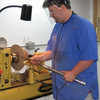I've mostly used my skews as negative rake scrapers, which works well but I have a very acute angle on my skew and so it dulls almost immediately. I recently purchased a 1" x 5/8" scraper that I want to turn into a NRS but was curious what angles people use (particularly for inside/outside of bowls)? I've read anywhere from 85/15 to 60/30.
Thanks,
Tom




 Reply With Quote
Reply With Quote




